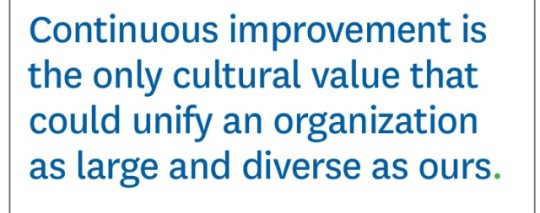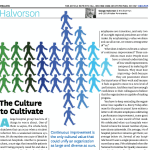There's a great piece, currently available for free on the HBR website, about continuous improvement:
The Culture to Cultivate
The author, George Halvorson, is the recently retired CEO of Kaiser Permanente and it's really helpful that he is writing about the power of a culture of continuous improvement. Here are some highlights from the column and my comments.
Halvorson talks about the serious nature of their work, which includes trying to reduce sepsis (“number one cause of death in American hospitals”) and pressure ulcers (” a sure sign that immobile patients aren't being properly cared for and also a gateway to mortality”).
He writes that most hospitals focus on asking staff to “adhere to best practices” (or what we might call “standardized work” in Lean). They are getting some excellent results, as he reports:
(On average, 7% of hospital patients in America get [a pressure ulcer]; we average below 1%. Several of our hospitals haven't seen a single pressure ulcer in more than a year.)
How does Kaiser do it? Is it because their CEO is a genius and a singularly-good leader? Is it because they have super secret best practices nobody else has? No, it's about culture.
That isn't because we follow processes that are unique to us. The right protocols for patient care are universally shared. It's not because of technology either, although we have invested in plenty of that. I believe the real difference is in our culture.
We have worked to instill a culture of continuous improvement. Our culture lets our employees know that if they see a way to do something better, they should take the initiative to point it out.
This is a really important culture. This is what Joe Swartz have written about in our Healthcare Kaizen books. KaiNexus, a technology company I work with, has a collaborative improvement platform that our customers are using to build or enhance their cultures of continuous improvement. I am really passionate about this and it's basically my life's work to help organizations create the culture that Halvorson describes.

Halvorson writes:
What does it take to cultivate a culture of continuous improvement? Three conditions must exist: People must have a rational understanding of how small improvements compound to make big differences. They must love improving—both because they are passionate about the importance of their work and because it feels so good to move to a new level of performance. And they must have enough confidence in their colleagues to believe that the organization is capable of making progress.
Joe and I have built on the word of the greats like Masaaki Imai and Norman Bodek (and others) who taught us that Kaizen is mainly about small improvements making a big difference. Too many organizations think Kaizen is only about formal weeklong events or projects. As one CEO I talked to said recently, he has a vision of 80% of his hospitals improvements coming from ideas generated and implemented by front-line staff, the rest being projects and events. These different modes of improvement go hand in hand.
Halvorson writes about the need to love improving. In my experience, people like improving, especially in healthcare, where it's so meaningful for their patients. Kaizen also helps create a more engaging, less frustrating environment — and it leads to better safety, quality, and cost, with less waiting time.
There's no shortage of intrinsic motivation in healthcare. Leaders need to lead! And, they need to know when to get out of the way. People will improve if they are given time, training, and leadership and when that improvement is connected to a mission that matters. Being told you can't have a sweater on your chair or a waste basket at your desk – people hate that because it's not Kaizen – it's a top-down chain.
In Halvorson's third point, he says that employees must have confidence in their colleagues. This means they need to have confidence in themselves — and great leaders build that confidence by coaching and mentoring through the Kaizen process, in supportive way. Starting with the tiniest of improvements can get the ball rolling to start building that confidence and enthusiasm.
Managers and leaders at all levels must have confidence in their employees and their ability to identify and implement improvements. If a leader thinks his people won't have ideas or that they'll have lousy ones, that will be a self-fulfilling prophecy.
Halvorson, again:
You have to keep reminding the organization how capable it is. Every Friday afternoon for the past six years I have written a letter to all 180,000 employees celebrating a performance improvement, some great research, or a new award of that week.
Organizations that have the most improvement activity and the most sustained improvement programs (becoming a culture) have leaders who talk about Kaizen or continuous improvement constantly. It can't be just one speech or an annual mention. At Franciscan St. Francis Health System (Joe Swartz's organization, featured in our book Healthcare Kaizen) has leaders, from the CEO to front-line managers, who reinforce the need for Kaizen (connecting to purpose) while encouraging, recognizing, and celebrating improvement.
There are a few other necessary conditions for a culture of continuous improvement that Halvorson didn't mention (he had limited space):
- There should be a “no layoffs due to continuous improvement” pledge (the CEO I mentioned earlier has made this pledge)
- People need to feel free to point out problems without management “shooting the messenger,” blaming, or ignoring what they've brought up
- Employees need to have time to work on improvement (the managers don't have time to do it all) – read more on this
- Different roles and departments need to be able to work together on systemic improvements that aren't sub-optimizing
Continuous improvement methodologies, like Lean and Kaizen, work in healthcare. It requires leadership at all levels. They are simple concepts, but not easy to put into practice without a lot of dedication, practice, and hard work.
To learn more about KaiNexus and our software that “makes improvement easier,” visit our website.
Please scroll down (or click) to post a comment. Connect with me on LinkedIn.
Let’s build a culture of continuous improvement and psychological safety—together. If you're a leader aiming for lasting change (not just more projects), I help organizations:
- Engage people at all levels in sustainable improvement
- Shift from fear of mistakes to learning from them
- Apply Lean thinking in practical, people-centered ways
Interested in coaching or a keynote talk? Let’s talk.
Join me for a Lean Healthcare Accelerator Trip to Japan! Learn More











Great article, Mark. Thanks for sharing. Culture is a much bigger deal than many people realize. The quote that I think describes it well is that “culture is what people do whan no one is telling them what to do”.
Yes, great point, Dean. I’ve been fortunate to see what has evolved into a “culture of continuous improvement,” meaning, as you put it, that people work on improvement continually without being “told” to do it.
Why do people participate in continuous improvement or kaizen?
1) It’s the right thing to do for patients and colleagues
2) It can be interesting to solve problems and think creatively
3) It can make your daily work less frustrating and more engaging
They don’t need extrinsic incentives, rewards, or all of the other “carrot” things that leaders try to force improvement or innovation.
Inspire people, help them, get out of the way.
Thanks for summarizing this Mark. Relatively small organizations have proven that leadership with a dogged determination and spirit of adventure can succeed with Lean, but these models are difficult to translate to the many super larger healthcare organizations. It seems that Kaiser gets it because their leader gets it.
A word to the wise is to assess the Leader before undertaking any transformation.
Hopefully they have been careful and made sure that Halvorson’s replacement also shares this understanding and passion for continuous improvement.
Kaiser has more than a culture of continuous improvement. It has thousands of employees who have adopted habits that support continuous improvement. These habits have become second nature and a way of being and doing, which frees up mental space for people to take on bigger challenges as well as more improvements. Very powerful.
As a very satisfied Kaiser patient/customer who sees many habits in action, I appreciate this blog post, Mark.